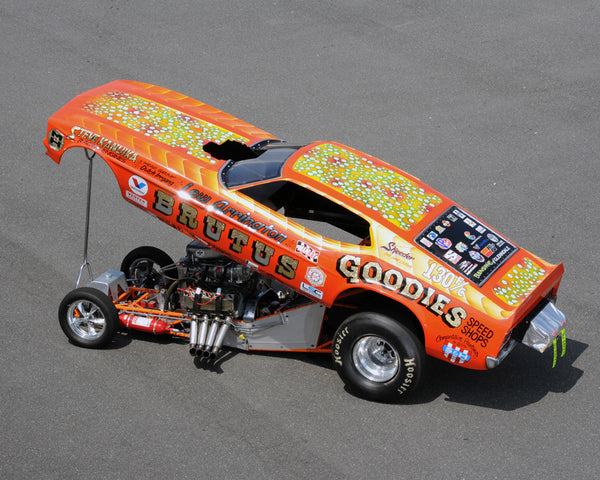Although it's often stated that the 1970s is the decade that taste forgot, I’ve never subscribed to the idea. It was an era that gave birth to so many exciting styles and movements, it was only inevitable that after enough time and mass-popularization each “scene” (be it music, fashion, decor, etc.) became an overblown, tasteless version of the original concept. Car modifying certainly suffered as badly as anything else. But interestingly enough, the catalyst to the first widespread custom scene—in Europe at least—was drag racing. In particular the Funny Cars of the 1970s.
If any motorsport series could lay claim to looking as loud as they sound, then surely drag racing is it! Even to this day, it's hard to eradicate those bad memories of dodgy home-improved street cars trying to capture that drag strip menace of the real things, but once you cast those aside, and see just how damn cool those early legitimate Funny Cars are, one can see the parallels with every other cultural phenomenon (look how punk, disco and rock etc, all became cartoon versions of the pure originals).




With very little, if any, sponsorship getting in the way, the designs on funny cars could be as mad and bad as the drivers and owners wanted. The populations of highly skilled sign-writers and spray-gunners were only outnumbered by the vast range of candy-colored, metal-flaked, retina-popping paint they had to choose from. Together they made for some truly wonderful examples as reflections of the times they were living in. If you wanted to describe car culture in the 1970s to an alien you've just met in a desert, you’d pretty much have to show it a Funny Car. That same alien isn't likely to ask why they're called that though—they are simply life-sized toy (looking) cars that shout outrageousness. But they also manage to be equally mean and purposeful in their looks, even if there’s a cartoon character on its flanks.


One could almost argue it's where my career as an automotive artist began. Ever since I can remember, I've been drawing cars and trucks, and after many early attempts at trying to design wedge-shaped super cars of Italian descent, it was the dragster shape that I found I could capture well enough at that age. But why would a young boy growing up in the heartland of British motorsport be so obsessed with this all-American form of racing? Well aside from the obvious exposure to American culture via TV and film, dragsters were simply like nothing else, and the styling was hugely popular. The white-lettered tire sidewall was to car customization what the safety pin was to punks. Unfortunately the chrome-dripping, flame-flowing, teardrop-window-conversion efforts did the same irreversible damage to style that the hugely flared, collared, and platform-booted disco suit ended up doing to the dance floor.




This was particularly true in the UK; whereas in the United States the street cars being customized were not only the road-going versions of the genuine Funny Cars, but they were also big enough to carry all those mods without looking overcrowded. Apply the same tactics to a Ford Anglia or a Morris Minor van though, and you end up with the original definition of having driven a car through an auto spares store where everything stuck! There were a few exceptions though, and I like to think my dad’s old Mk1 V6 Capri in the ’70s was one of those. The slightly raised rear suspension, side-exit exhausts, Wolfrace alloys and matte black bonnet where all simple, effective mods in pursuit of a dragster look.
Back on the quarter mile, the other big difference between the road and the ‘strip were the names given to these creations. Where else do cars take on and become such characters as Jungle Jim? The cars are the stars in this sport more than any other (save for monster trucks maybe) and they all had crazy names we can remember as easy as superheroes, all thanks to the wacky and wonderful sign-writing emblazoned all along the bodywork. So I'd put Jungle Jim in with Johnny Rotten when it comes to being the original form of the culture. These cars really are the voice of a decade... A very, very loud one.




Image sources:dragshop.net ,racingjunk.com ,draglist.com pinterest.com ,bangshift.com




















































